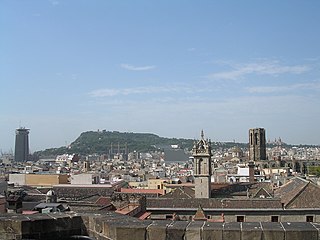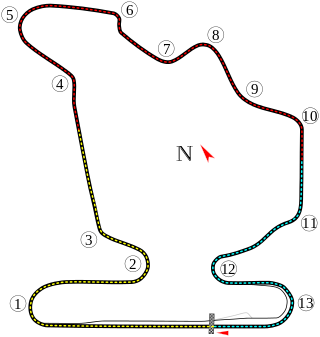
Montjuïc is a hill in Barcelona, Catalonia, Spain.

The 1992 Summer Olympics, officially known as the Games of the XXV Olympiad and commonly known as Barcelona '92, was an international multi-sport event held from 25 July to 9 August 1992 in Barcelona, Catalonia, Spain. Beginning in 1994, the International Olympic Committee decided to hold the Summer and Winter Olympics in alternating even-numbered years. The 1992 Summer and Winter Olympics were the last games to be staged in the same year. These games were the second and last two consecutive Olympic games to be held in Western Europe after the 1992 Winter Olympics in Albertville, France, held five months earlier.

The Spanish Grand Prix is a Formula One motor racing event currently held at the Circuit de Barcelona-Catalunya. The race is one of the oldest in the world still contested, celebrating its centenary in 2013. The race had modest beginnings as a production car race. Interrupted by the First World War, the race waited a decade for its second running before becoming a staple of the European calendar. In 1927 it was part of the World Manufacturers' Championship; it was promoted to the European Championship in 1935 before the Spanish Civil War brought an end to racing. The race was successfully revived in 1967 and has been a regular part of the Formula One World Championship since 1968 at a variety of venues.

The Circuit de Barcelona-Catalunya is a 4.657 km (2.894 mi) motorsport race track in Montmeló, Barcelona, Catalonia, Spain. With long straights and a variety of corners, the Circuit de Barcelona-Catalunya is seen as an all-rounder circuit. The track has stands with a capacity of 140,700. The circuit has FIA Grade 1 license.

The Pedralbes Circuit was a 6.333 km (3.935 mi) street racing course in Barcelona, Catalonia, Spain.

Circuito de Jerez – Ángel Nieto, is a 4.428 km (2.751 mi) racing circuit located close to the city of Jerez de la Frontera, 90-kilometre (56 mi) south of Seville and deep within the sherry-producing region in the south of Spain. The project was led by the Spanish engineer Manuel Medina Lara, based on a preliminary idea from Alessandro Rocci.

Estadi Olímpic Lluís Companys is a stadium in Barcelona, Catalonia, Spain. Originally built in 1927 for the 1929 International Exposition in the city, it was renovated in 1989 to be the main stadium for the 1992 Summer Olympics and 1992 Summer Paralympics. It is the home stadium of FC Barcelona for the 2023–24 season, due to the renovation of their regular ground, the Camp Nou.

The Montjuïc circuit was a street circuit located on the Montjuïc mountain in Barcelona, Catalonia, Spain. The circuit was also the venue for the Spanish motorcycle Grand Prix from 1950 to 1968, and then hosted the event on even-numbered years until 1976. The last Formula One Grand Prix held there in 1975, is notable for both a fatal crash that led to Formula One abandoning the venue and the only occasion to date that a female driver has scored World Championship points.

The Catalan motorcycle Grand Prix is a motorcycling event held at the Circuit de Barcelona-Catalunya in Barcelona, Catalonia, Spain, as part of the FIM Grand Prix motorcycle racing season. Between 2022 and 2026, Circuit de Barcelona-Catalunya is due to host at least three Grands Prix.

The Algarve International Circuit, commonly referred to as Portimão Circuit, is a 4.653 km (2.891 mi) race circuit located in Portimão, Algarve region, Portugal. The development includes a karting track, off-road track, technology park, five-star hotel, sports complex and apartments.

The Hungarian motorcycle Grand Prix was a motorcycling event that had been part of the Grand Prix motorcycle racing World Championship.

Autódromo Termas de Río Hondo is a 4.805 km (2.986 mi) motorsport circuit located in Termas de Río Hondo, Argentina. The circuit was opened in 2008 and underwent a complete overhaul and rebuild process in 2012, based on design by the Italian circuit designer Jarno Zaffelli.

Piscines Bernat Picornell is a swimming venue situated in the Olympic Ring in Montjuïc, Barcelona. The venue consists of three swimming pools: a 50m indoor pool, a 50m outdoor pool, and a pool for diving. It hosted the swimming events, synchronized swimming events, the water polo final, and the swimming part of the modern pentathlon event for the 1992 Summer Olympics.

For the 1976 Summer Olympics, a total of twenty-seven sports venues were used. Several venues used had been in existence before Montreal made its first Olympic bid in the late 1930s. By the 1950s, Montreal's bid for the Olympics shifted from Winter to Summer before it was finally awarded the 1976 Summer Games in 1970. Strikes in 1974 and 1975 affected construction of the Montreal Olympic Park, most notably the stadium, pool, and velodrome, to the point where the FINA President threatened to not have the diving, swimming, and water polo events take place there for the games in early 1976 though all three venues were completed as best as possible prior to the 1976 Games. 27 swimming world records were set as a result. The oldest stadium, Molson Stadium at McGill University, would be converted into artificial turf for the field hockey tournaments while the sailing program in Kingston, Ontario, would be held in freshwater, both for the first time in Summer Olympic history. Indoor track cycling took place at the Olympics for the first time at the velodrome. Once the Olympics finished, the Montreal Expos and Montreal Alouettes moved into Olympic Stadium, staying until 2004 and 1997, respectively. The Montreal Canadiens remained at the Montreal Forum until they moved to the Molson Centre in March 1996. In 1992, the velodrome was converted into an indoor zoo now known as the Montreal Biodôme. Île-Notre Dame hosted a canoe sprint world championships and two rowing world championships since the 1976 Games, but the area north of the basin on the island has been host to the Formula One Canadian Grand Prix on an almost annual basis since 1978.
Barcelona, the capital of Catalonia, is the second largest city and metropolitan area in Spain and sixth-most populous urban area in the European Union. It has hosted many major international tournaments and has professional teams in different sports.

The 2018 Catalan motorcycle Grand Prix was the seventh round of the 2018 Grand Prix motorcycle racing season. It was held at the Circuit de Barcelona-Catalunya in Montmeló on 17 June 2018.

The 2020 Catalan motorcycle Grand Prix was the ninth round of the 2020 Grand Prix motorcycle racing season and the eighth round of the 2020 MotoGP World Championship. It was held at the Circuit de Barcelona-Catalunya in Montmeló on 27 September 2020.

The 2021 FIM Moto2 World Championship was a part of the 73rd F.I.M. Road Racing World Championship season. Remy Gardner won the world championship in the final race at Valencia. This season also saw the retirement of the intermediate class veteran Thomas Lüthi, as well the final season a 250cc-era debutant participated in the intermediate class.

The 2021 FIM Moto3 World Championship was a part of the 73rd F.I.M. Road Racing World Championship season. Pedro Acosta secured the 2021 championship with one race left in the season, which was marred by the death of Jason Dupasquier during the second qualifying session of the Italian Grand Prix.

The 2021 Catalan motorcycle Grand Prix was the seventh round of the 2021 Grand Prix motorcycle racing season and the third round of the 2021 MotoE World Cup. It was held at the Circuit de Barcelona-Catalunya in Montmeló on 6 June 2021.


















